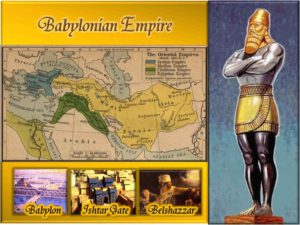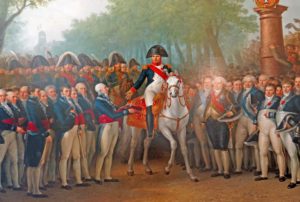Once a Prophet by the name Isaiah asked a question. “Can a country be born in a day or a nation brought forth in a moment? Yet no sooner is Zion in labor than she gives birth to her children.” (Isa 66:8) And that’s exactly what happened on May 14th 1948 in Israel: This prophecy was fulfilled, there has never been any other nation in the history of the world that has been over thrown scattered all over the world, like Israel was in 70 AD then 2,000 years later the land of Zion re-emerged, and they are an distinct and individual people once again! Yes it’s true the people of Israel have returned to their land. I was just over there in Jan.-Feb, 2019 and it is amazing to see God’s chosen people once again restoring their ancient land and have revived their ancient language it’s truly a miracle of God! Israel
NOW for a LITTLE HISTORY LESSON: To understand Biblical prophecy you must know the history of Israel because Israel is the key to all BIBLICAL PROPHECY! And holy land history
Pre-Biblical Period 4000-2000 B.C.
We know that the oldest known communities on earth were in the Holy Land, in about 2160-2100 B.C. Abraham arrived in Canaan. If you remember he left the land of Ur of the Chaldeans near the Persian Gulf in what is today modern Iraq,then after a few years in Haran, which is north of Canaan, he came into the land under the leadership of God.
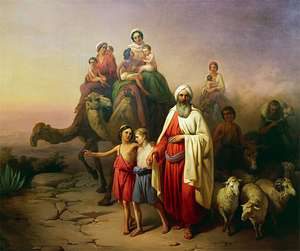
1445 B.C.: God calls Moses at the burning bush in Exodus 3:2, to lead the children of God out of Egyptian bondage after 400 years.

1400 B.C.: Joshua enters the Promised Land.
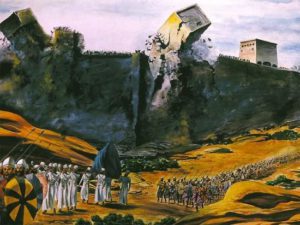
1200 B.C.: Philistines from Crete invade Israel and occupy five principal cities along the Mediterranean coast: Ashdod, Ashkelon, Gath, Gaza and Ekron.
1025 B.C.: Saul was crowned as Israel’s first king!

1004-965 B.C.: David reigns as King of Israel.
965-922 B.C.: Solomon reigns as King of Israel and builds the first Temple in Jerusalem on the site of the threshing floor of Araunah the Jebusite, which had been purchased by his father, King David. And we have all read that King David battles a lot of enemies!

920 B.C.: At the death of Solomon: Israel is divided into the Northern and Southern Kingdom; Israel in the North, with its capital at Samaria, which had the 10 tribes and in the South was Judah with its capital in Jerusalem, having only Judah and Benjamin.
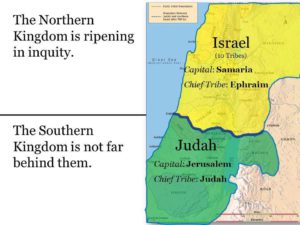
722B.C’: Assyria captures the 10 tribes of the Northern Kingdom and takes them into captivity to the north and they are lost to history!
605–562 B.C. The BABYLONIAN PERIOD
605 B.C. Nebuchadnezzar lays siege to Jerusalem and takes away captives to Babylon. Daniel the prophet is the first group of the captives.
586 B.C. Nebuchadnezzar attacks Jerusalem and this time destroys the Temple of Solomon, and carries away the treasures of the Temple and takes Judah captive to Babylon.
549–332 B.C. The PERSIAN PERIOD
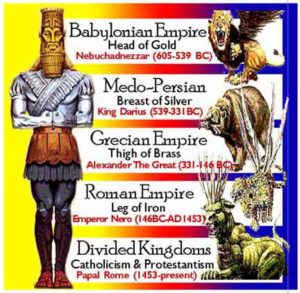
536 B.C. Cyrus allows the Jews to return to Jerusalem exactly 70 years after their captivity as prophesied by Jeremiah and Daniel.
445 B.C. Artaxerses issues the decree to restore and rebuild Jerusalem. This is the beginning of Daniel’s 70 weeks of prophecy in the book of Daniel 9:24-27
332–167 B.C. THE GREEK PERIOD
332 B.C. Alexander the Great conquers Israel. When he died, his kingdom is divided into fourths, and Israel is ruled by the Ptolemy’s of Egypt.
197 B.C. Israel passes into the hands of the Seleucid Empire when Antiochus III defeats the Egyptians at Caesarea Philippi.
175 B.C. Antiochus IV (Epiphanies) of Syria becomes king.
167 B.C. Antiochus abolishes worship of Jehovah and desecrates the second Temple in Jerusalem by offering a swine on the Temple altar and in-stalling a statue of the Olympian Zeus.
167–63 B.C. HASMONEAN PERIOD
In response to the atrocities of Antiochus, the Jews revolt under the leadership of the Maccabaean brothers and overthrow the Seleucids. The Jews now have about 100 years of self-rule under their own leaders known as the Hasmoneans. It was during this period that two opposing groups sprang up, the Pharisees and the Sadducces.
63 B.C.–330A.D. ( “A.D.” stands for a Latin phrase: anno domini (“in the year of the Lord”—the year Jesus was born)
63 B.C. Pompey conquers Israel for Rome.
40 B.C. The Parthians surprise the Romans under leadership of Antigonus and took the land.
39 B.C. Herod the Great expels the Parthians and the Romans are once again in command. Herod is rewarded by Rome and becomes the King of the Jews and reigns until his death in 4 B.C.
4-1 B.C. In this time period, Jesus was born in Bethlehem.
32 A.D. Jesus was crucified in Jerusalem.
66 A.D. This is the year of the first Jewish revolt which started in Caesarea led by the Zealots.
70 A.D. In response to the Jewish revolt, Titus destroys the Temple and the city of Jerusalem is burned to the ground. The Jewish people are scattered in what is known as the Great Diaspora or Scattering, into the four corners of the earth and for nearly 2,000 years there is no Israel.
132 A.D. The Jews who remained in the land revolt against the Romans a second time under the leadership of Bar Kokhba, and once again are further scattered and badly defeated.
135 A.D. The Roman Emperor Hadrian rebuilds Jerusa-lem as a Roman and much smaller city. He moves the line of the walls on the southern side to their present location and changes the name of Jerusalem to Aelia Capitolina. He changes Judea to Syria Palestina, Syria of the Philistines and from their the name Palestine (Isaiah 14:29,31) He also issues a decree that no Jew can re-approach the city under penalty of death.
312–634 A.D. BYZANTINE PERIOD
Constantine becomes the Roman Emperor in 312 A.D. He has a vision during a battle in which he sees a cross in the sky and the words, “In This Sign Conquer.” He becomes a Christian and declares the Roman Empire Christianized, which brings persecution and suffering to an end, but also moves Christianity from being people-oriented to building- and institution-oriented. Pagan priests now become Christian priests and the living church is infiltrated with people whose hearts have not been changed by the power of the living Lord Jesus Christ. The Christian religion spreads rapidly through-out the Roman world which eventually leads to the Roman Catholic or Universal Church which was birthed in the early 5th century. This also brings a split in the empire and Constantinople, Istanbul of today, becomes the capital of the eastern half of the Roman Empire.
607-629 A.D 2nd PERSIAN PERIOD
While things in Europe were changing, so was Israel. On May 20, 614, Jerusalem was overrun by the Persians, Christian churches were destroyed, and the work of about 300 years construction was almost whipped out. The Church of the Holy Sepulcher in Jerusalem was destroyed, while the Church of the Nativity in Bethlehem was spared by the Grace of God!
634-1099 A.D. Arab Period
570 A.D. Mohammed is born in Mecca. When he is 43, he receives a series of revelations, which later becomes the Koran, the “Bible” of the Moslems, and in 632A.D. he dies; however, in this short period of 19 years, he is able to bring the Arab tribes together with this new religion.
636 A.D. After the death of Mohammed, a split occurs between his leadership and two branches of Islam develop, the Shiites and the Sunnites or Sunnis. As a result of this split, Jerusalem becomes the third holiest city in Islam, next to Mecca and Medina in Saudi Arabia of today!
1009 A.D. Fatimid Caliph Hakim issues the order to destroy the Church of the Holy Sepulcher again, and this began the destruction of 30,000 Christian buildings in Israel. This action was the spark that set off the Crusades.
1099-1263 A.D. CRUSADER PERIOD
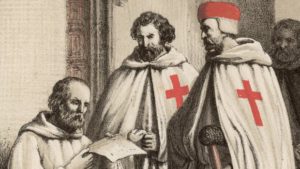
1099 A.D. The Crusaders from Europe arrive in Israel and Jerusalem is captured from the Moslems. This is the beginning of the Latin Kingdom of Jerusalem.
1187 A.D. A Moslem prince named Saladin from Egypt gains control of Egypt, Syria, Mesopotamia and Israel (or Palestine) and defeats the Crusaders in a battle at the Horns of Hittin in Galilee. The battle rage on and the Christians gain control for a short period of 13 years before losing it again to the Mongol tribes from central Asia in the early 13th century.
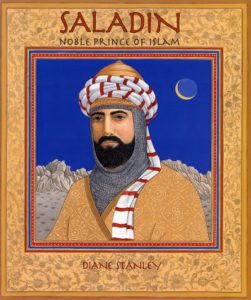
1263-1516 A.D. MAMELUKE PERIOD
1263 A.D. The Mamelukes of Egypt capture the few remaining Crusader strongholds along the coast and hold them intermittently for the next 250 years.
1517-1917 A.D. TURKISH PERIOD
1517 A.D. The Ottoman Turkish Empire, which was birthed after the breakup of the great Mongol Empire of Genghis Khan, it spread into the Middle East in the early years of the 16th century and held the land for 400 years while reigning from Constantinople. The Turks cut all the trees in the Holy Land and used them to build railroads, etc., throughout their empire.
1799 A.D. Napoleon tries to add Palestine to his kingdom but fails at Acre.
1917 A.D. Under the leadership of the British General Allenby, a devoted Christian, Jerusalem is liberated by the Allies at the end of World War I
1917 A.D. to PRESENT
1878 A.D. The first of the early pioneers return to the land and establish a village at Petah Tikvah.
1909 A.D. The first Kibbutz in the land is founded at the southern tip of the Sea of Galilee and named Degania.
1917 A.D. The land is liberated from the Turks. The Balfour Declaration, proclaiming the need for a Jewish homeland in so-called Palestine, is announced by the British Lord Balfour. This is a very important day as it signals the soon return to the land of the Jewish people in large numbers. Between the years 1917-1944 many Jews try to return to the land but they are limited by quotas placed by the British who are afraid the Moslems. Because of this, millions die in Nazi concentration camps.
1922 A.D. The British Mandate over Palestine is confirmed by the League of Nations.
1947 A.D. The League of Nations offers the Moslem Palestinians an opportunity to have a state of their own alongside Israel, but they refuse. This leads to a Partition Plan between Israel and Jordan that is adopted by the United Nations.
1948 A.D. On May 14, the State of Israel was re-born in fulfillment of Biblical Prophecy, and the British withdraw. This is the beginning the Jewish War of Independence. The war officially ends July 18 and Israel is established on a small portion of their land; however, they do not have possession of Jerusalem, Judea or Samaria. This land is now known as Trans Jordan and is under the control of the Jordanians. (Could this be the budding of the fig tree, Jesus was talking about in the Matthew 24:32? I think so!)
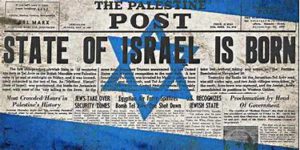
1949 A.D. David Ben-Gurion becomes the first Prime Minister of Israel. He is a Zionist and an atheist.
1956 A.D. Israel fights with Egypt after the Egyptians, led by Gamal Abdul Nasser, nationalize the Suez Canal in July. In October, the Israelis end up occupying nearly all of the Sinai Peninsula. After peace terms are agreed upon, Israel pulls back to the 1949 armistice lines and U.N. forces are stationed along the Israeli-Egyptian border.
1967 On May 23, Egypt closes the Gulf of Aqaba to Israeli shipping, and on June 5, the famous Six Day War breaks out. After just six days, the Israelis liberate Samaria and Judea (so-called West Bank) by pushing the Syrians out of the Golan Heights in the north, the Jordanians from Jerusalem across the Jordan River to the east, and the Egyptians out of the Sinai to the south. For the first time since 70 A.D. the Jews have control of Jerusalem and now have access to the Wailing Wall.
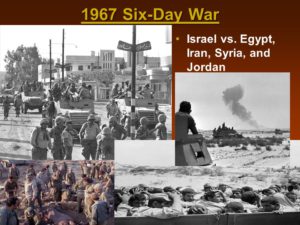
1969 A.D. Golda Meir becomes Israel’s fourth Prime Minister. 1970-73 A.D. Israel fights a war of Attrition in the Jordan Valley against the Jordanians.
1973 A.D. On October 6, the holiest day of the Jewish year, Yom Kippur (Day of Atonement), Israel is attacked by Syria and Egypt. Israel holds the territory and is victorious but not without the loss of many young Jewish lives.
1979 A.D. On March 26, Egyptian President Anwar Sadat and Israeli Prime Minister Menachem Begin sign a peace treaty in Washington D.C. Later Mr. Sadat is assassinated by Moslem fundamentalists.
1982 A.D. In response to continued missile attacks from Lebanon, Israel enters southern Lebanon on June 5, and establishes a security belt between Lebanon and Israel.
1985 A.D. Israel annexes the Golan Heights.
1986 A.D. The Arab Moslem Intifada breaks out and Israel begins a campaign of containment,
1994 A.D Israel agrees to give up land for peace and enters into an agreement with Yasser Arafat and the PLO which gives the PLO control of Gaza and Jericho.
1995 A.D. Israel plans negotiations with Syria that will result in giving up the Golan Heights which leads to widespread dissension among the Israelis. On November 4, Prime Minister Yitshak Rabin is assassinated and becomes the first Prime Minister in Jewish history to be killed by one of his own. In December, Israel gives over control of Bethlehem and Nablus to the PLO.
1996 A.D. Benjamin Netanyahu is elected Prime Minister, replacing Shimon Peres. Israel pulls out of Hebron as part of a treaties. The population of Israel is now 5.9 million.
1997 A.D. Israel and the Palestinians reach agreement on Israeli redeployment in the West-Bank city of Hebron and the Hebron Protocol is signed by Israel and the Palestinian Authority.
2001 A.D. Ariel Sharon is elected Prime Minister and Israel withdraws from the Gaza Strip.
2002 A.D. The “Quartet” (United States, European Union, Russia and United Nations) proposes the Road Map for Peace to resolve Israeli-Palestinians conflict and create an independent Palestinian state. The Israeli army launches Operation Defensive Shield on the West Bank after several Palestinian suicide bombings. This was the largest military operation on the West Bank since 1967.
2003 A.D. Israel and the Palestinian Authority accept the Road Map for Peace, which requires a freeze on the West Bank Jewish settlements and an end to the attacks on Israelis. A right-of-center coalition government is formed by Prime Minister Ariel Sharon.
2005 A.D. Israel carries out the Disengagement Plan, ending Israel’s presence in the Gaza Strip. Israel withdraws all the Jewish settlers and military personnel from Gaza, while retaining control over airspace, costal waters and border crossings.
2006 A.D Ehud Olmert becomes acting Prime Minister. Israeli incursion into Lebanon, in response to deadly Hezbollah attack and abduction of two soldiers escalates into a second Lebanon War. (Shimon Peres is elected President by the Knesset: “intifada”)
2007 A.D. The Palestinian Unity Agreement (Mecca Agreement) is signed in Mecca. The Annapolis Conference establishes, for the first time, a “two-state solution” as the basis for future talks between Israel and the Palestinian National Authority.
2008 A.D. Arabs threaten to withdraw its proposed Arab peace Initiative if Israel does not accept it. Israel launches its Gaza Operation (Operation Cast Lead) in response to the barrage of more than 10,000 rockets and mortars fired from the Gaza Strip.
2009 A.D. Benjamin Netanyahu is elected Prime Minister. The population of Israel is now 7.5 million and about 5.62 million are Jewish.
2013 A.D. Israel launches a week-long military campaign against Gaza-based armed groups following months of escalating rocket attacks on Israeli towns. Talks resume with Palestinian Authority under U.S. auspices, but reach no conclusions. Israel, Jordan, and the Palestinian Authority sign an agreement to save the Dead Sea from drying up by pumping water from the Red Sea. “You got to love the Irony”
2014 A.D. Israel responds to attacks by armed groups in Gaza with military campaign by air and land to knock out missile launching sites and attack tunnels. Clashes end in an uneasy Egyptian-brokered cease fire in August.
2015 A.D. Prime Minister Netanyahu forms a new coalition government after March elections with right-wing Bayit Yehudi (Jewish Home) party. Israel suspends contact with EU officials in talks with Palestinians over the EU decision to label goods from Jewish settlements in the West Bank as coming not from Israel but from settlements. Permanent members of the UN and Iran reach a controversial nuclear deal which Israel opposes.
2016 A.D. The U.S. agrees to a military aid package worth $38Billion over the next 10 years for Israel, the largest such deal in U.S. History. Israel suspends working ties with 12 countries that voted for Security Council resolution condemning settlement building after the U.S., for the first time, abstained from the vote rather than using its veto.
2017 A.D. President Trump and Netanyahu meet and announce U.S./Israel relations are reset. Trump denounces the Iranian nuclear deal and does not back a two-state solution. Israeli population exceeds 8 million.
Dec. 6, 2017 WASHINGTON — President Trump on Wednesday formally recognized Jerusalem as the capital of Israel, reversing nearly seven decades of American foreign policy and setting in motion a plan to move the United States Embassy from Tel Aviv to the fiercely contested Holy City.

2018/2019 A.D. Coming SOON!


